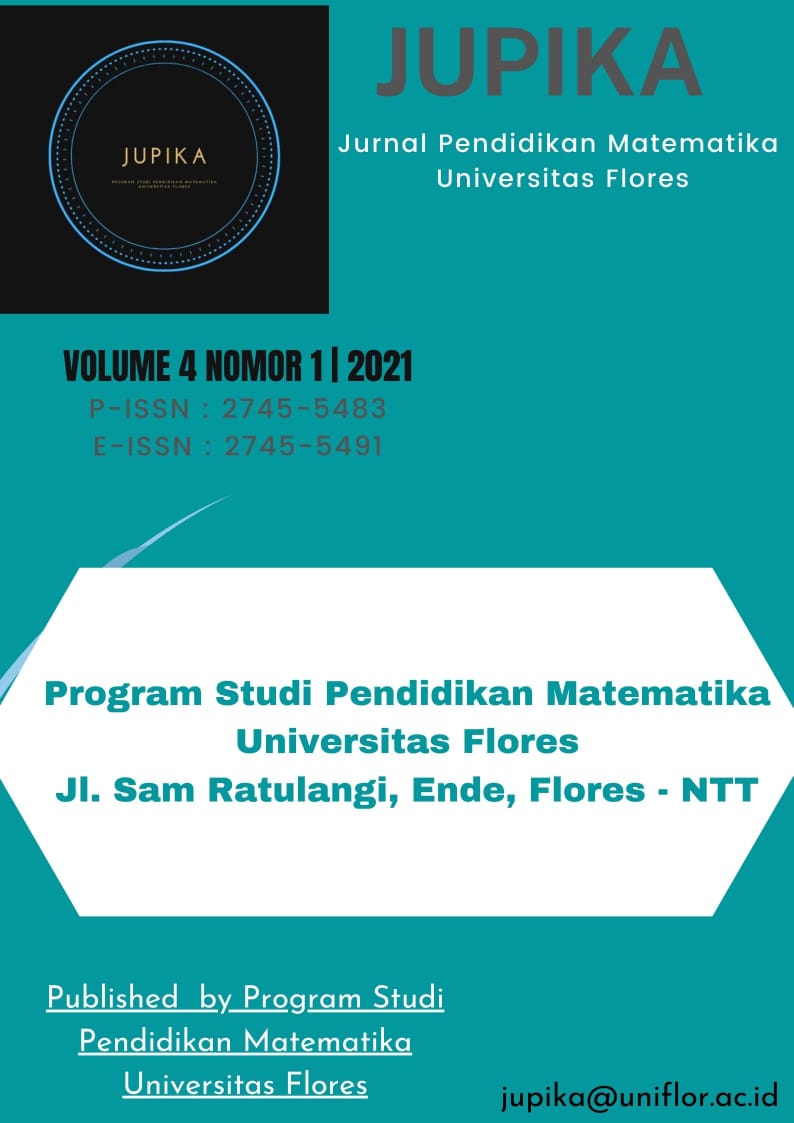EKSPLORASI ETNOMATEMATIKA NGADHU DAN BHAGA DALAM KAITANNYA DENGAN PEMBELAJARAN MATEMATIKA PADA MASYARAKAT DESA UBEDOLUMOLO KABUPATEN NGADA
DOI:
https://doi.org/10.37478/jupika.v4i1.846Abstract
This study aims to determine: (1) to identify the structure of ngadhu and bhaga in Ubedoulumolo Village of Ngada District. (2) Explain the relation of ngadhu and bhaga to mathematics learning in school. The research method used is qualitative with an ethnographic approach. The subjects of this study consisted of three informants (pengu chief, and traditional elders of pengu and gelo tribe). Using observation and interview techniques, supported by documentation, and using qualitative descriptive analysis. The results of the study showed ngadhu and bhaga has related to mathematics, that is the geometry concept. The geometry concept found in ngadhu is: (1) pole ngadhu (made of sebu tree) in the form of a tube; (2) base of ngadhu is composed of a stone in a circle; (3) the roof of ngadhu (material of reeds and palm fibre) in the shape of a cone; (4) bhenga (2 roof support posts) in the form of a beam; (5) mangu (NOK pole) shaped beam; (6) sobhe (head ngadhu made of bamboo) shaped tube; (7) paja (roof truss of bamboo) formed triangle, rectangles, trapezoid. The geometry concept in the bhaga building are: (1) bhaga in the form of the beam; (2) roof (made of reeds) in the shape of a trapezoid and triangular prism; (3) pole shape of beams and tubes; (4) Ube (wall made of plank wood fai) shape of the rectangle; (5) Dawu (arranged boards) with carvings in the form of circles and triangle; (6) Soku bhotha and soku wi’i ( as a roof truss made of bamboo) shape tube rectangle, square and triangle. Geometry forms that exist in the ngadhu and bhaga in the Ubedolumolo Village are lines, angles, triangle, square, rectangle, trapezoid, circle, beam. Tube, cone and triangular prism.
Downloads
Keywords:
Exploration, Ethnomathematics, Geometry, Ngadhu and BhagaReferences
Bramasti, R. 2012. Kamus Matematika. Surakarta : Aksarra Sinergi Media.
D’Ambrosio, U. (1985). Ethnomathematics and its place in the history and pedagogy of mathematics. For the Learning of Mathematics, 5(1), 44-48.
Fitriani , Somakim, & Hartono . 2018. Eksplorasi Etnomatematika pada Budaya Masyarakat Jambi Kota Seberang. Journal of Mathematics Education IKIP Veteran semarang, Volume 2, No.2, 2018,pp. 145-149
Hariastuti, R. M. 2017. Permainan Tebak-Tebak Buah Manggis: Sebuah Inovasi Pembelajaran Matematika Berbasisi Etnomatematika. Jurnal Matematika dan pendidikan Matematika, Vol. 2, No. 1, 25-35
Hartoyo, A. (2012). Eksplorasi Etnomatematika Pada Budaya Masyarakat Dayak Perbatasan Indonesia-Malaysia Kabupaten Sanggau Kalbar. Jurnal Penelitian Pendidikan, Vol. 13, No.1, 14-23
Indriyani, S. (2017). Eksplorasi etnomatematika pada Aksara Lampung. Skripsi. Tidak diterbitkan. Fakultas Tarbiyah dan keguruan. Universitas Islam Negeri Raden Intan: Lampung
Maure, O. P. & Ningsi, G. P. (2013) . Eksplorasi Etnomatematika Pada Tarian caci Manggarai Nusa Tenggara Timur, Prosiding Seminar Nasional Etnomatnesia
Negoro, S.T. & Harahap B. 2010. Ensiklopedia Matematika. Bogor Selatan: Ghalia Indonesia
Rachmawati, I. 2012. Eksplorasi Etnomatematika Masyarakat Budiarjo. Ejournal. Surabaya: FMIPA UNESA. Diunduh tanggal 21 mei 2020
Romadoni, A.N. 2017. Aspek-Aspek Etnomatematika pada Budaya Masyarakat Banjar dan Pengunaan Aspek-Aspek Tersebut Untuk pengembangan Paket Pembelajaran Matematika. Tesis. FKIP, Universitas Sanata Dharma, Yogyakarta
Sa’o Sofia. (2017). Dasar-dasar Matematika pendidikan. Salatiga: Widya Sari
Sari, Eka Fitri Puspa; Somakim, Somakim; Hartono, Yusuf. Etnomatematika pada Kebudayaan Rumah Adat Ogan Komering Ulu Sumatera Selatan. Journal of Medives : Journal of Mathematics Education IKIP Veteran Semarang, [S.l.], v. 2, n. 1, p. 137-144, jan. 2018. ISSN 2549-5070. Available at: <http://e-journal.ivet.ac.id/index.php/matematika/article/view/557>. Date accessed: 29 mar. 2021. doi: https://doi.org/10.31331/medives.v2i1.557.
Downloads
Published
How to Cite
Issue
Section
License
![]() JUPIKA: JURNAL PENDIDIKAN MATEMATIKA is licensed under a Creative Commons Attribution-ShareAlike 4.0 International License.
JUPIKA: JURNAL PENDIDIKAN MATEMATIKA is licensed under a Creative Commons Attribution-ShareAlike 4.0 International License.







